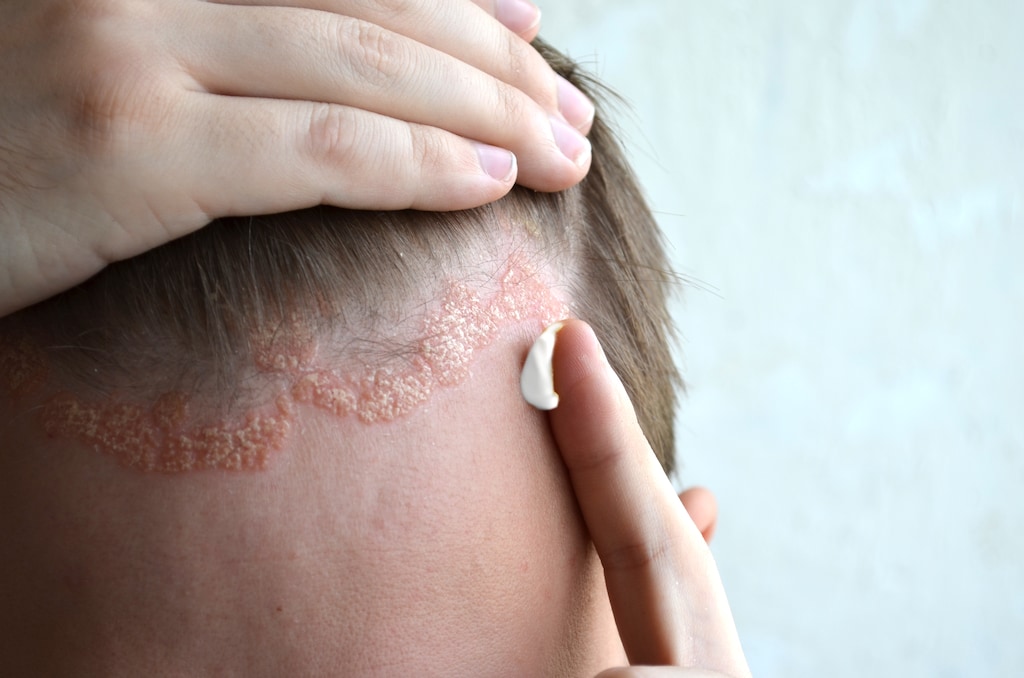Dosage Forms
Excipient information presented when available (limited, particularly for generics); consult specific product labeling.
Lotion, External:
Duobrii: Halobetasol propionate 0.01% and tazarotene 0.045% (100 g) [contains edetate disodium dihydrate, methylparaben, propylparaben]
Pharmacology
Mechanism of Action
Halobetasol is a high range potency topical corticosteroid with anti-inflammatory, antipruritic, and vasoconstrictive properties. May depress the formation, release, and activity of endogenous chemical mediators of inflammation (kinins, histamine, liposomal enzymes, prostaglandins) through the induction of phospholipase A2 inhibitory proteins (lipocortins) and sequential inhibition of the release of arachidonic acid.
Tazarotene is a synthetic, acetylenic retinoid which modulates differentiation and proliferation of epithelial tissue and exerts some degree of anti-inflammatory and immunological activity.
Use: Labeled Indications
Plaque psoriasis: Treatment of plaque psoriasis in adults.
Contraindications
Pregnancy
Dosage and Administration
Dosing: Adult
Plaque psoriasis: Topical: Lotion: Apply a thin layer to affected areas once daily; total dosage should not exceed 50 g/week. Discontinue therapy when control is achieved.
Dosing: Geriatric
Refer to adult dosing.
Administration
Topical: For external use only; not for ophthalmic, oral, or intravaginal use; do not apply to the face, groin, or axillae. Use of occlusive dressings is not recommended unless directed by a health care provider. Ensure affected areas are dry prior to application. Apply thin film to affected areas and rub in gently. Wash hands after application (unless treating hands).
Storage
Store at 20°C to 25°C (68°F to 77°F); excursions permitted to 15°C to 30°C (59°F to 86°F). Protect from freezing.
Drug Interactions
Aldesleukin: Corticosteroids may diminish the antineoplastic effect of Aldesleukin. Avoid combination
Corticorelin: Corticosteroids may diminish the therapeutic effect of Corticorelin. Specifically, the plasma ACTH response to corticorelin may be blunted by recent or current corticosteroid therapy. Monitor therapy
Deferasirox: Corticosteroids may enhance the adverse/toxic effect of Deferasirox. Specifically, the risk for GI ulceration/irritation or GI bleeding may be increased. Monitor therapy
Hyaluronidase: Corticosteroids may diminish the therapeutic effect of Hyaluronidase. Management: Patients receiving corticosteroids (particularly at larger doses) may not experience the desired clinical response to standard doses of hyaluronidase. Larger doses of hyaluronidase may be required. Consider therapy modification
Ritodrine: Corticosteroids may enhance the adverse/toxic effect of Ritodrine. Monitor therapy
Warnings/Precautions
Concerns related to adverse effects:
- Adrenal suppression: May cause hypercortisolism or suppression of hypothalamic-pituitary-adrenal (HPA) axis, particularly in younger children or in patients receiving high doses for prolonged periods. HPA axis suppression may lead to adrenal crisis.
- Local effects: Local adverse reactions may occur (eg, skin atrophy, striae, telangiectasias, folliculitis, contact dermatitis); may be irreversible. Local adverse reactions are more likely to occur with use of higher potency corticosteroids, occlusive dressings and/or prolonged use. If local adverse reactions develop, discontinue use and institute appropriate therapy until skin integrity is restored. Do not restart if allergic contact dermatitis is identified. Avoid use on eczema.
- Ocular effects: Topical corticosteroids may increase the risk of posterior subcapsular cataracts and glaucoma. Monitor for ocular symptoms. Avoid contact with eyes.
- Photosensitivity: May cause photosensitivity; exposure to ultraviolet rays (including sunlight/sunlamps) should be avoided unless deemed medically necessary, and in such cases, exposure should be minimized. Risk may be increased by concurrent therapy with known photosensitizers (thiazides, tetracyclines, fluoroquinolones, phenothiazines, sulfonamides); use with caution. Daily sunscreen use and other protective measures recommended. Patients with sunburn should discontinue use until sunburn has healed.
- Skin infections: Use appropriate antibacterial or antifungal agents to treat concomitant skin infections; discontinue treatment if infection does not resolve promptly.
- Systemic effects: Topical corticosteroids may be absorbed percutaneously. Absorption of topical corticosteroids may cause manifestations of Cushing syndrome, hyperglycemia, or glycosuria. Absorption is increased by the use of occlusive dressings, application to denuded skin, or application to large surface areas.
Special populations:
- Women of reproductive potential: Evaluate pregnancy status prior to use in females of reproductive potential. A negative pregnancy test should be obtained within 2 weeks prior to treatment; treatment should begin during a normal menstrual period. Adequate contraception should be used in females of reproductive potential.
Monitoring Parameters
Signs/symptoms of HPA axis suppression/adrenal insufficiency; bacterial or fungal skin infection; disease severity in plaque psoriasis during therapy (reduction in erythema, scaling, induration); clinical response and skin tolerance; pregnancy test within 2 weeks prior to treatment in females of reproductive potential.
Pregnancy
Pregnancy Considerations
Based on the tazarotene component, use in pregnancy is contraindicated.
Evaluate pregnancy status prior to use in females of reproductive potential. A negative pregnancy test should be obtained within 2 weeks prior to treatment; treatment should begin during a normal menstrual period. Adequate contraception should be used in females of reproductive potential.
Refer to individual monographs for additional information.




